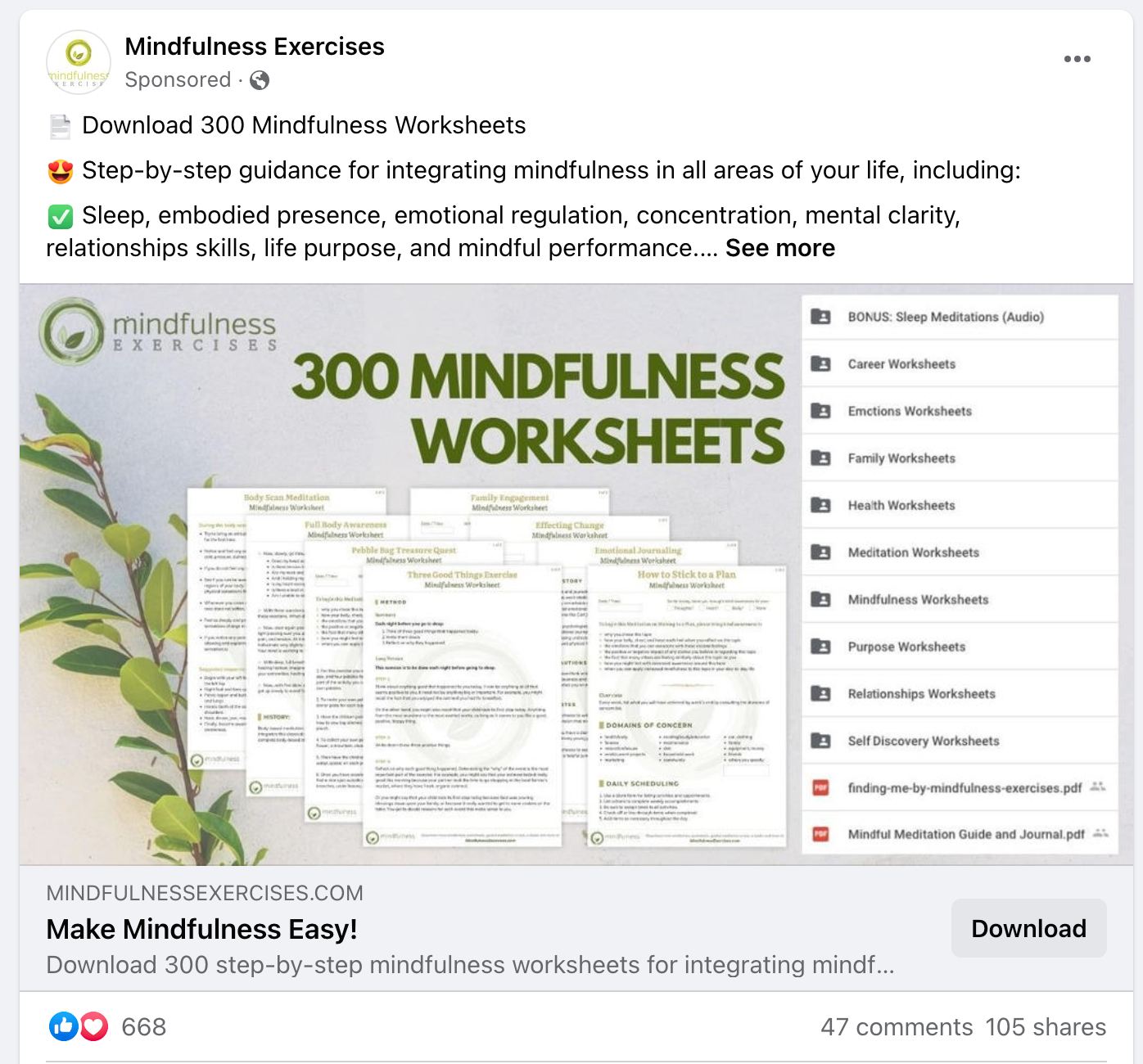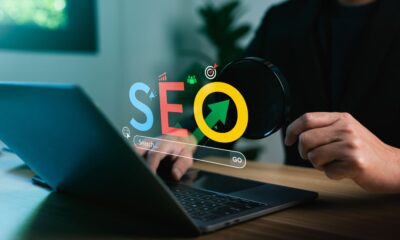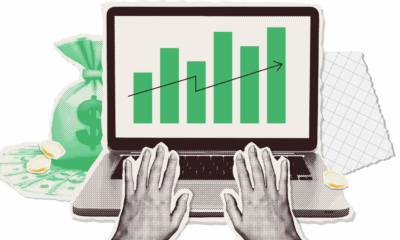PPC
Five Lead Magnets that Complement Paid Traffic

If you are using ads to generate sales for a course or any other product, that costs more than $100, a lead magnet should be part of the funnel. As your conversion rates will be higher when you take the time to nurture the lead and build trust before pitching your product.
There are so many types of lead magnets out there that it can be hard to decide the best one for your ad. This is why I have made a list of the best lead magnets that work well with ads.
1. Ebooks
Ebooks are a popular lead magnet you will notice when you browse through your Facebook or Instagram feed. They range from cheat sheets, templates, checklists, worksheets, and so many other types.
Source: Facebook
They’re popular because they are easy to create. You can just get a template, add your content and branding such as colors, font, and logo, and publish it in less than a week.
The type of lead magnet you use should depend on the product you are promoting. For example, if your product is a video course, a guide that provides a glimpse of some of the content you cover in the course would work well.
While if you are selling high-ticket consulting services, a case study where you share details about a result you got for a client would do well. This is because potential clients will want to see proof of experience and credibility before investing in high-ticket services.
Another important factor to keep in mind is the amount of free time your target audience has available. If you’re targeting busy people a case study or template would do better, but if your audience has more free time you can use long ebooks and white papers.
2. Webinars
Businesses use webinars as lead magnets to promote all sorts of products like courses, consulting services, and software. I have even seen marketers use them to sell eCommerce products. They are popular because people will always be interested in signing up for one-time live events. They can lower your CPA (cost per acquisition).

Source: Instagram
Also, a good percentage of webinar attendees convert to sales as people are more receptive to your pitches after a live educative presentation.
To get the best results, don’t just think of the webinar as a live event. Picture it as a complete funnel. This includes the follow-up emails you send after the webinar. As more people will buy after the webinar ends, especially when the deadline gets closer.
You can also automatically deliver a satisfaction survey after the deadline to find out why someone bought the product or didn’t. This will help you create better products and improve your funnel.
Another great thing about webinars is that after the live event, you can reuse the recording and build an evergreen webinar funnel around it. Most webinar platforms let you record the webinar. Some marketers take the recording and gate it behind a sign-up form on their website and use a funnel that is similar to the live event. When people sign up for this webinar they need to choose a time to watch it at and they receive pre and post-webinar emails.

Source: Amy Porterfield
There are several platforms that make it easy to set up an evergreen webinar. But if you go down this route, make sure you don’t ever tell attendees that it is a live event. As it is important to build a trustworthy relationship with potential customers.
Even though there are so many parts to a webinar, the most important one is the video presentation itself. Make sure you get it right by filling it with lots of unique tips your audience hasn’t heard before. You should also get the timing right. Webinar attendees prefer it when webinars are 45 minutes long. This should include a short introduction, the presentation, the pitch, and a Q&A session at the end. Do your best to make it fun and engaging to limit the number of people who drop out in between.
Another important factor is the time at which you run your webinar. Usually, the afternoon or evening (after people finish work) is the best time. You can use the satisfaction survey to learn about what timings people prefer.
3. Quizzes
One of the most important aspects of marketing is specificity. If you can understand your audience and write highly specific content and copy, you will generate a lot more sales. This is why top marketers constantly run surveys and track email activity such as opens and clicks after people sign up to their list.
But if you use quizzes, you can figure this out even before people sign up, like in this quiz from DoFasting.

Source: DoFasting
It sells products that make it easier for people to fast. So, it uses this quiz to learn about its audience. In the beginning, it enquires about the quiz participants’ genders. After that, it displays many multi-choice questions related to their experience with fasting. Towards the end, it asks for more personal details like the height and age of participants. Finally, in the end, it creates a free report. But people can’t just download this free report, they need to provide their email to get it.

This helps DoFasting attract highly qualified leads. As it segments people who sign up based on their answers. They receive very specific emails that increase conversions and reduce unsubscriptions.
You can also create several custom audiences with these segmented email lists and retarget subscribers with extremely-relevant ads.
4. Polls
The problem with quizzes is that it takes time for participants to finish them. The duration depends on the complexity of the quiz. In contrast, people can sign up for other lead magnets in a few seconds by just providing their email addresses. This is why a lot of people will abandon your quiz mid-way.
An alternative to a quiz is a poll. In a poll, instead of asking people to answer multiple questions, you just ask them to answer one or two multiple-choice questions. This attracts more participants.
You also won’t need to use a sophisticated tool to create a personalized report that will entice them to sign up. You can simply ask them to sign up to see the results of the poll. There are a lot of poll makers that make it easy to set this up.
5. Content upgrades
A content upgrade is a lead magnet you create for one specific blog post like in this post on how to write a blog post. You will notice that there is a call to action for a blog post template at the top. As the lead magnet is very relevant to the topic of the post, it will generate a lot of leads.

Source: Social Marketing Writing
They work well with ads, especially on platforms like Facebook and Instagram because these networks like it when you promote educative content like blog posts that aren’t gated behind a landing page. You will be able to achieve a lower CPC (cost per click) rate and generate more leads at the same time because of the content upgrade.
Content upgrades are also very effective for converting organic traffic you generate from social media and search engines. Make sure you embed the opt-in form directly in the blog post several times so that readers don’t miss it. Some great places to add it are the top, middle, and end.
In the beginning, you can place the opt-in forms in these three areas, but after you start driving traffic, you can analyze how visitors interact with the blog post and forms using heat maps and scroll maps. You can then shift the forms to the best locations. You can also experiment with the messaging and color of the forms and call to action buttons.
Now create the lead magnets for your ads
When you promote inexpensive products there’s no necessity to use a lead magnet. It will just lengthen your funnel and delay the sale. But when you sell more expensive products, you can’t skip the lead magnet. They will help you build relationships with prospects and generate sales. This could be in a few days or months from now as you can regularly email the leads, nurture them, and pitch your products.
Therefore, use this guide to determine the best lead magnet for your funnel and to generate maximum leads and sales from your ads.
















You must be logged in to post a comment Login